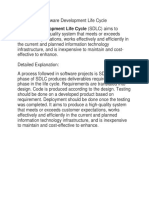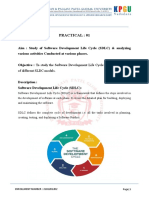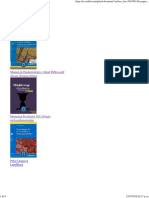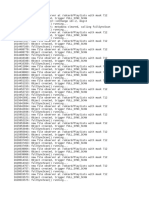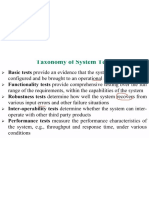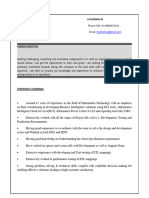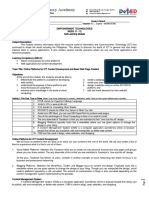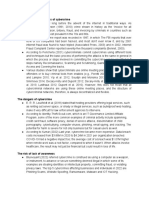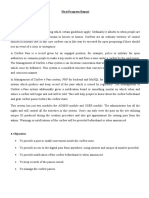Practical 1-2
Practical 1-2
Uploaded by
Vrajkumar PatelCopyright:
Available Formats
Practical 1-2
Practical 1-2
Uploaded by
Vrajkumar PatelCopyright
Available Formats
Share this document
Did you find this document useful?
Is this content inappropriate?
Copyright:
Available Formats
Practical 1-2
Practical 1-2
Uploaded by
Vrajkumar PatelCopyright:
Available Formats
SOFTWARE ENGINEERING
PRACTICAL : 01
Aim : Study of Software Development Life Cycle (SDLC) & analyzing
various activities Conducted at various phases.
Objective : To study the Software Development Life Cycle (SLDC) and study of
different SLDC models.
Description :
Software Development Life Cycle (SDLC):
Software Development Life Cycle (SDLC) is a framework that defines the steps involved in
the development of software at each phase. It covers the detailed plan for building, deploying
and maintaining the software.
SDLC defines the complete cycle of development i.e. all the tasks involved in planning,
creating, testing, and deploying a Software Product.
ENROLLMENT NUMBER : 2101201193 Page|1
SOFTWARE ENGINEERING
SDLC is a process that defines the various stages involved in the development of software for
delivering a high-quality product. SDLC stages cover the complete life cycle of a software i.e.
from inception to retirement of the product.
Adhering to the SDLC process leads to the development of the software in a systematic and
disciplined manner.
Purpose of SDLC is to deliver a high-quality product which is as per the customer’s
requirement.
Phases of SDLC Cycle :
• Requirement gathering and analysis
• Design
• Implementation or coding
• Testing
• Deployment
• Maintenance
1. Requirement Gathering and Analysis :
During this phase, all the relevant information is collected from the customer to develop a
product as per their expectation. Any ambiguities must be resolved in this phase only.
Business analyst and Project Manager set up a meeting with the customer to gather all the
information like what the customer wants to build, who will be the end-user, what is the
purpose of the product. Before building a product a core understanding or knowledge of the
product is very important.
ENROLLMENT NUMBER : 2101201193 Page|2
SOFTWARE ENGINEERING
For Example, A customer wants to have an application which involves money transactions.
In this case, the requirement has to be clear like what kind of transactions will be done, how
it will be done, in which currency it will be done, etc.
Once the requirement gathering is done, an analysis is done to check the feasibility of the
development of a product. In case of any ambiguity, a call is set up for further discussion.
Once the requirement is clearly understood, the SRS (Software Requirement Specification)
document is created. This document should be thoroughly understood by the developers and
also should be reviewed by the customer for future reference.
2. Design :
In this phase the system and software design is prepared from the requirement specifications
which were studied in the first phase. System Design helps in specifying hardware and
system requirements and also helps in defining overall system architecture. The system
design specifications serve as input for the next phase of the model.
In this phase the testers comes up with the Test strategy, where they mention what to test,
how to test.
3. Implementation or Coding :
On receiving system design documents, the work is divided in modules/units and actual
coding is started. Since, in this phase the code is produced so it is the main focus for the
developer. This is the longest phase of the software development life cycle.
4. Testing :
Testing starts once the coding is complete and the modules are released for testing. In this
ENROLLMENT NUMBER : 2101201193 Page|3
SOFTWARE ENGINEERING
phase, the developed software is tested thoroughly and any defects found are assigned to
developers to get them fixed.
Retesting, regression testing is done until the point at which the software is as per the
customer’s expectation. Testers refer SRS document to make sure that the software is as per
the customer’s standard.
5. Deployment :
After successful testing the product is delivered / deployed to the customer for their use.
As soon as the product is given to the customers they will first do the beta testing. If any
changes are required or if any bugs are caught, then they will report it to the engineering
team. Once those changes are made or the bugs are fixed then the final deployment will
happen.
6. Maintenance :
Once when the customers starts using the developed system then the actual problems comes
up and needs to be solved from time to time. This process where the care is taken for the
developed product is known as maintenance.
After the deployment of a product on the production environment, maintenance of the
product i.e. if any issue comes up and needs to be fixed or any enhancement is to be done is
taken care by the developers.
ENROLLMENT NUMBER : 2101201193 Page|4
SOFTWARE ENGINEERING
Software Development Life Cycle Models :
A software life cycle model is a descriptive representation of the software development cycle.
SDLC models might have a different approach but the basic phases and activity remain the
same for all the models. There are several SDLC Models listed below :
• Waterfall Model
• V – Shaped Model
• Prototype Model
• Spiral Model
• Iterative Incremented Model
• Big Bang Model
• Agile Model
❖ Waterfall Model :
Waterfall model is the very first model that is used in SDLC. It is also known as the linear
sequential model.
In this model, the outcome of one phase is the input for the next phase. Development of the
next phase starts only when the previous phase is complete.
▪ First, Requirement gathering and analysis is done. Once the requirement is freeze then
only the System Design can start. Herein, the SRS document created is the output for
the Requirement phase and it acts as an input for the System Design.
▪ In System Design Software architecture and Design, documents which act as an input
for the next phase are created i.e. Implementation and coding.
▪ In the Implementation phase, coding is done and the software developed is the input for
the next phase i.e. testing.
▪ In the testing phase, the developed code is tested thoroughly to detect the defects in the
software. Defects are logged into the defect tracking tool and are retested once
ENROLLMENT NUMBER : 2101201193 Page|5
SOFTWARE ENGINEERING
fixed. Bug logging, Retest, Regression testing goes on until the time the software is in
go-live state.
▪ In the Deployment phase, the developed code is moved into production after the sign
off is given by the customer.
▪ Any issues in the production environment are resolved by the developers which come
under maintenance.
Advantages of Waterfall Model :
➢ Waterfall model is the simple model which can be easily understood and is the one in
which all the phases are done step by step.
➢ Deliverables of each phase are well defined, and this leads to no complexity and makes
the project easily manageable.
ENROLLMENT NUMBER : 2101201193 Page|6
SOFTWARE ENGINEERING
Disadvantages of Waterfall Model :
➢ Waterfall model is time-consuming & cannot be used in the short duration projects as
in this model a new phase cannot be started until the ongoing phase is completed.
➢ Waterfall model cannot be used for the projects which have uncertain requirement or
wherein the requirement keeps on changing as this model expects the requirement to be
clear in the requirement gathering and analysis phase itself and any change in the later
stages would lead to cost higher as the changes would be required in all the phases.
❖ Prototype Model :
The prototype model is a model in which the prototype is developed prior to the actual
software.
Prototype models have limited functional capabilities and inefficient performance when
compared to the actual software. Dummy functions are used to create prototypes. This is a
valuable mechanism for understanding the customers’ needs.
Software prototypes are built prior to the actual software to get valuable feedback from the
customer. Feedbacks are implemented and the prototype is again reviewed by the customer
for any change. This process goes on until the model is accepted by the customer.
ENROLLMENT NUMBER : 2101201193 Page|7
SOFTWARE ENGINEERING
Once the requirement gathering is done, the quick design is created and the prototype which
is presented to the customer for evaluation is built.
Customer feedback and the refined requirement is used to modify the prototype and is again
presented to the customer for evaluation. Once the customer approves the prototype,
It is used as a requirement for building the actual software. The actual software is build
using the Waterfall model approach.
Advantages of Prototype Model :
➢ Prototype model reduces the cost and time of development as the defects are found
much earlier.
➢ Missing feature or functionality or a change in requirement can be identified in the
evaluation phase and can be implemented in the refined prototype.
➢ Involvement of a customer from the initial stage reduces any confusion in the
requirement or understanding of any functionality.
Disadvantages of Prototype Model :
➢ Since the customer is involved in every phase, the customer can change the requirement
of the end product which increases the complexity of the scope and may increase the
delivery time of the product.
❖ Spiral Model :
The Spiral Model includes iterative and prototype approach.
Spiral model phases are followed in the iterations. The loops in the model represent the
phase of the SDLC process i.e. the innermost loop is of requirement gathering & analysis
which follows the Planning, Risk analysis, development, and evaluation. Next loop is
Designing followed by Implementation & then testing.
ENROLLMENT NUMBER : 2101201193 Page|8
SOFTWARE ENGINEERING
Spiral Model has four phases:
▪ Planning
▪ Risk Analysis
▪ Engineering
▪ Evaluation
(i) Planning :
The planning phase includes requirement gathering wherein all the required information
is gathered from the customer and is documented. Software requirement specification
document is created for the next phase.
(ii) Risk Analysis :
In this phase, the best solution is selected for the risks involved and analysis is done by
building the prototype.
For Example, the risk involved in accessing the data from a remote database can be that
the data access rate might be too slow. The risk can be resolved by building a prototype
of the data access subsystem.
ENROLLMENT NUMBER : 2101201193 Page|9
SOFTWARE ENGINEERING
(iii) Engineering :
Once the risk analysis is done, coding and testing are done.
(iv) Evaluation :
Customer evaluates the developed system and plans for the next iteration.
Advantages of Spiral Model:
➢ Risk Analysis is done extensively using the prototype models.
➢ Any enhancement or change in the functionality can be done in the next iteration.
Disadvantages of Spiral Model:
➢ The spiral model is best suited for large projects only.
➢ The cost can be high as it might take a large number of iterations which can lead to high
time to reach the final product.
ENROLLMENT NUMBER : 2101201193 Page|10
SOFTWARE ENGINEERING
PRACTICAL : 02
Aim : Compare and Contrast all the process model in tabular view.
Objective : To study and compare all the SDLC process models in a tabular
format.
Description :
Parameter ▼ Waterfall Incremental Prototype RAD
Process Model ► Model Model Model Model
Clear
Requirements Initial Level Initial Level Medium Level Initial Level
Specifications
Feedback from user No No Yes No
Speed to change Low High Medium No
Predictability Low Low High Low
Risk Identification At Initial Level No No No
Practically No Low Medium Low
Implementation
Systematic Iterative Priority on Use
Loom Sequence Sequence Customer Ready-made
Feedback Component
Any variation done Yes V-Model No No No
Understandability Simple Intermediate Intermediate Intermediate
Requirement Core Product Clear Idea Clean Idea
Precondition clearly should clearly of Quick of reused
defined defined design Component
Usability Basic Medium High Medium
Customer Priority Nil Nil Intermediate Nil
Industry Approach Basic Basic Medium Medium
Cost Low Low High Very High
Resource Yes Yes Yes Yes
Organization
Elasticity No No Yes Yes
ENROLLMENT NUMBER : 2101201193 Page|11
SOFTWARE ENGINEERING
Parameter ▼ Spiral Agile XP
Process Model ► Model Model Programming
Clear
Requirements Initial Level Change Incrementally Initial Level
Specifications
Feedback from user No No Yes
Speed to change High High High
Predictability Medium High High
Risk Identification Yes Yes Yes
Practically Medium High High
Implementation
Identification Highly customer Customer
Loom of risk at satisfaction and satisfaction and
each stage Incremental Incremental
development Development
Any variation done Yes No No
Understandability Hard Much Complex Intermediate
Precondition No No No
Usability Medium Most used now-a-days Medium
Customer Priority Intermediate High Intermediate
Industry Approach Medium High Medium
Cost Expensive Much Expensive High
Resource No No Yes
Organization
Elasticity No Very High Medium
ENROLLMENT NUMBER : 2101201193 Page|12
You might also like
- ArchestrA Training Manual Class 1Document524 pagesArchestrA Training Manual Class 1Eduardo Andres Ramos RojasNo ratings yet
- Power Query - Solution Book PDFDocument113 pagesPower Query - Solution Book PDFGermán Darío León Cardona80% (5)
- 001 Introduction To Business AnalyticsDocument57 pages001 Introduction To Business Analyticsjc enriquez100% (2)
- Astaghfirullah SapDocument5 pagesAstaghfirullah SapAZIRIAL HAYKEL AB AZIZNo ratings yet
- SDLC Interview QuestionDocument6 pagesSDLC Interview QuestionAkshay MahtoNo ratings yet
- ISACA Azure ChecklistDocument30 pagesISACA Azure Checklistkenny152200% (2)
- Se PracticalDocument18 pagesSe PracticalVrajkumar PatelNo ratings yet
- Introduction and Basic of Software ModellingDocument19 pagesIntroduction and Basic of Software ModellingtruptiNo ratings yet
- 1.what Is Software Development Life Cycle (SDLC) ?Document9 pages1.what Is Software Development Life Cycle (SDLC) ?masudNo ratings yet
- Software Development Life Cycle ProcessDocument9 pagesSoftware Development Life Cycle ProcessGoverment Goverment100% (1)
- Module-5 - Development of MIS-1Document4 pagesModule-5 - Development of MIS-1Subham .MNo ratings yet
- SDLC (Software Development Life Cycle) Phases, Methodologies, Process, and ModelsDocument12 pagesSDLC (Software Development Life Cycle) Phases, Methodologies, Process, and ModelsSunil PawarNo ratings yet
- Software Development Life CycleDocument14 pagesSoftware Development Life CycleKaushik RayNo ratings yet
- What Is Software Development Life Cycle (SDLC) ? Learn SDLC Phases, Process, and ModelsDocument13 pagesWhat Is Software Development Life Cycle (SDLC) ? Learn SDLC Phases, Process, and ModelsLoc NguyenBaoNo ratings yet
- What Is SDLC?: Requirement Gathering and AnalysisDocument5 pagesWhat Is SDLC?: Requirement Gathering and AnalysisSakshi ShriwasNo ratings yet
- Unit 1 DevopsDocument59 pagesUnit 1 DevopsRohith RockNo ratings yet
- Unit 2-1Document12 pagesUnit 2-1hk979324No ratings yet
- Software Development Life Cycle (SDLC)Document40 pagesSoftware Development Life Cycle (SDLC)Anonymous aQxekTRNo ratings yet
- ASM LifecycleDocument9 pagesASM LifecycleLe Van Dung (BTECHCM)No ratings yet
- SE NotessDocument15 pagesSE NotessNidhin EdappalNo ratings yet
- Unit 1 (Part 2) Software EngineerDocument24 pagesUnit 1 (Part 2) Software EngineerMansiNo ratings yet
- R20 IT 4-1 - DevOps - UNIT - 1Document23 pagesR20 IT 4-1 - DevOps - UNIT - 1Bitra Venugopal100% (1)
- SDLCDocument14 pagesSDLCHimanshu AggarwalNo ratings yet
- Devops MateiralDocument173 pagesDevops MateiralRITHIK ROYNo ratings yet
- Unit 1 DevopsDocument52 pagesUnit 1 Devopspravalika.godishalNo ratings yet
- Se ModelsDocument15 pagesSe ModelsSyed Aman BukhariNo ratings yet
- SE Module 1Document30 pagesSE Module 1aswathysethumadhavan.247No ratings yet
- UNIT 1 Software EngineeringDocument20 pagesUNIT 1 Software Engineeringramitak.cse.jisu21No ratings yet
- Devops Full NotesDocument223 pagesDevops Full NotesNakshatra SNo ratings yet
- LaupDocument6 pagesLaupTK Lý Nguyễn Tuấn KiệtNo ratings yet
- SE Practicals6503Document173 pagesSE Practicals6503Apex LegendNo ratings yet
- Se ch1Document55 pagesSe ch1mubarek muhammedNo ratings yet
- AGILE (1 New)Document81 pagesAGILE (1 New)aswinNo ratings yet
- Assignment SDLCDocument11 pagesAssignment SDLCThànhNo ratings yet
- DevOps Course FileDocument179 pagesDevOps Course Filefruitnnut010No ratings yet
- IntroDocument70 pagesIntroAyan DasNo ratings yet
- Devops Unit 1Document57 pagesDevops Unit 1vivekNo ratings yet
- Unit Ii - Project Life Cycle and Effort Estimation 2.1 Software Process and Process ModelsDocument19 pagesUnit Ii - Project Life Cycle and Effort Estimation 2.1 Software Process and Process Models123No ratings yet
- Software Engineering Course MaterialDocument29 pagesSoftware Engineering Course Materialvikas desaleNo ratings yet
- The Stages of SDLC Are As Follows:: SE Unit-2 SDLC and Process ModelsDocument12 pagesThe Stages of SDLC Are As Follows:: SE Unit-2 SDLC and Process ModelsRushmitha SelvarajNo ratings yet
- SE Unit - I NotesDocument71 pagesSE Unit - I Notesokchaitanya568No ratings yet
- 02.1 Software Development LifecycleDocument20 pages02.1 Software Development Lifecycleissa.i.shabanNo ratings yet
- Software Development Life Cycle (SDLC)Document27 pagesSoftware Development Life Cycle (SDLC)Shalengss OiccelNo ratings yet
- Software Eng. Mat - 5Document29 pagesSoftware Eng. Mat - 5Gaurav MarothiaNo ratings yet
- What Is SDLC?Document11 pagesWhat Is SDLC?viktorNo ratings yet
- SDLC & ModelsDocument11 pagesSDLC & ModelsGaurav ChauhanNo ratings yet
- OOSEDocument93 pagesOOSEMeghana BaradNo ratings yet
- Software Development Life CycleDocument6 pagesSoftware Development Life CycleNilupul WijeratneNo ratings yet
- Software Development Life Cycle (SDLC)Document125 pagesSoftware Development Life Cycle (SDLC)winster21augNo ratings yet
- Se PracticalDocument39 pagesSe PracticalDeepNo ratings yet
- Software Development Life Cycle - Waterfall ModelDocument18 pagesSoftware Development Life Cycle - Waterfall ModelKhenielle Cooper100% (1)
- Software Development Life Cycle: Prof. Arvinder KaurDocument60 pagesSoftware Development Life Cycle: Prof. Arvinder KaurmeranaamsarthakhaiNo ratings yet
- ModelssdlcDocument36 pagesModelssdlcKaushal AnandNo ratings yet
- Tools Chap-1Document19 pagesTools Chap-1metasebiamerkin7275No ratings yet
- Software Development Life CycleDocument5 pagesSoftware Development Life CycleTarun GargNo ratings yet
- Lec 2Document28 pagesLec 2Akash SatputeNo ratings yet
- SPM Unit 2Document22 pagesSPM Unit 2shubhshubham616No ratings yet
- Software Engineering - Full - NotesDocument85 pagesSoftware Engineering - Full - NotesLeslie QwerNo ratings yet
- SPM Unit 2 NotesDocument19 pagesSPM Unit 2 NotesMAYANK RAGHAVNo ratings yet
- Software Life CyclesDocument12 pagesSoftware Life Cyclesbajelisanjay03No ratings yet
- Chapter 2Document37 pagesChapter 2future tubeNo ratings yet
- Manual Testing and SeleniumDocument155 pagesManual Testing and SeleniumSanthiya LakshmananNo ratings yet
- Models SDL CDocument29 pagesModels SDL Cyash vermaNo ratings yet
- SDLC (Software Development Lifecycle) - Is A Systematic Process For Building Software That Ensures The Quality and Correctness of The SoftwareDocument36 pagesSDLC (Software Development Lifecycle) - Is A Systematic Process For Building Software That Ensures The Quality and Correctness of The SoftwareqwertyNo ratings yet
- Software Testing Interview Questions You'll Most Likely Be AskedFrom EverandSoftware Testing Interview Questions You'll Most Likely Be AskedNo ratings yet
- FODS IMPORTANT QuestionDocument4 pagesFODS IMPORTANT QuestionVrajkumar PatelNo ratings yet
- CN Practical ZDocument16 pagesCN Practical ZVrajkumar PatelNo ratings yet
- CN PracticalDocument17 pagesCN PracticalVrajkumar PatelNo ratings yet
- Practical 1 2Document18 pagesPractical 1 2Vrajkumar PatelNo ratings yet
- Se Practical ZDocument18 pagesSe Practical ZVrajkumar PatelNo ratings yet
- Se PracticalDocument19 pagesSe PracticalVrajkumar PatelNo ratings yet
- Introduction To PsychologyDocument9 pagesIntroduction To PsychologyRe LzNo ratings yet
- INTEL-SA-00075 Detection and Mitigation Guide 1.1Document16 pagesINTEL-SA-00075 Detection and Mitigation Guide 1.1Sebastian GeorgescuNo ratings yet
- Information Technology PolicyDocument3 pagesInformation Technology Policyae.ltd.hsNo ratings yet
- Playlist ObserverDocument6 pagesPlaylist Observerricardogarcia1724gjNo ratings yet
- VPC PeeringDocument48 pagesVPC PeeringsivakumarNo ratings yet
- FinalDocument278 pagesFinalPritam Raha RoyNo ratings yet
- Database Terminology: Relational Databases Terms Glossary-Bonus ResourceDocument8 pagesDatabase Terminology: Relational Databases Terms Glossary-Bonus ResourceRufus GodonouNo ratings yet
- St&qa Unit 3Document31 pagesSt&qa Unit 3Arjun DomleNo ratings yet
- Chaitanya ResumeDocument4 pagesChaitanya Resumechaitanya mycherlaNo ratings yet
- Test Strategy Document: Version #: Date of IssueDocument6 pagesTest Strategy Document: Version #: Date of IssuevenukomanapalliNo ratings yet
- (Name of Project) : Test StrategyDocument9 pages(Name of Project) : Test StrategyTyler HarrisonNo ratings yet
- Dependency Injection in Python. Building Flexible and Testable - by Patrick Kalkman - ITNEXTDocument18 pagesDependency Injection in Python. Building Flexible and Testable - by Patrick Kalkman - ITNEXTHồ Bảo QuốcNo ratings yet
- Going Headless Through PWAs AMP On Salesforce Commerce Cloud Magento Shopify Plus SAP Commerce Cloud Hybris Oracle Commerce CloudDocument12 pagesGoing Headless Through PWAs AMP On Salesforce Commerce Cloud Magento Shopify Plus SAP Commerce Cloud Hybris Oracle Commerce CloudrustedchainsawNo ratings yet
- Dos Donts of E-Commerce TransactionsDocument11 pagesDos Donts of E-Commerce Transactionsnupur jhodNo ratings yet
- Sqli Book PDFDocument52 pagesSqli Book PDFmd tawfique100% (1)
- Empowerment Technologies-Module 6Document6 pagesEmpowerment Technologies-Module 6Marilie Espera100% (3)
- JMBADocument7 pagesJMBAWise MixNo ratings yet
- BIT Sem 1 - Chapter1Document54 pagesBIT Sem 1 - Chapter1Raveesha ThathsaraniNo ratings yet
- LogcatDocument9,354 pagesLogcateduardo gonzalesNo ratings yet
- Cyber CrimeDocument2 pagesCyber CrimeJeraldine RamisoNo ratings yet
- Abeer-Reem ProgrammingDocument8 pagesAbeer-Reem ProgrammingruxlixNo ratings yet
- CYBER SECURITY - TipsDocument21 pagesCYBER SECURITY - Tipssneha muralidharanNo ratings yet
- Functions MTU DiaSys V2.73 PRODocument8 pagesFunctions MTU DiaSys V2.73 PROwaleed EllafiNo ratings yet
- Generic UI DevelopmentDocument22 pagesGeneric UI Developmentaayush kumarNo ratings yet
- 1st Progress ReportDocument6 pages1st Progress ReportRohit ChavanNo ratings yet






















































